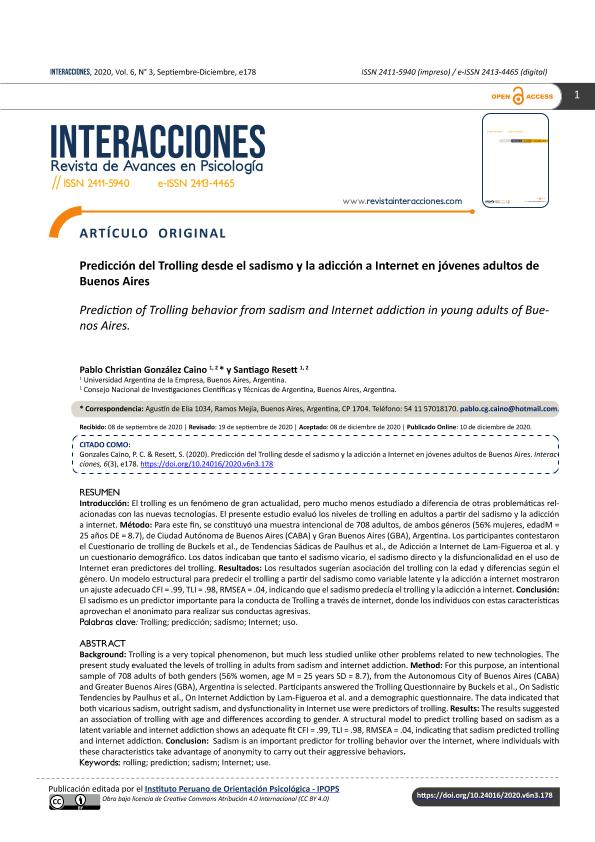Artículo
Introducción : El trolling es un fenómeno de gran actualidad, pero mucho menos estudiado a diferencia de otras problemáticas relacionadas con las nuevas tecnologías. El presente estudio evaluó los niveles de trolling en adultos a partir del sadismo y la adicción a internet. Método : Para este fin, se constituyó una muestra intencional de 708 adultos, de ambos géneros (56% mujeres, edad M = 25 años DE = 8.7), de Ciudad Autónoma de Buenos Aires (CABA) y Gran Buenos Aires (GBA), Argentina. Los participantes contestaron el Cuestionario de trolling de Buckels et al., de Tendencias Sádicas de Paulhus et al., de Adicción a Internet de Lam-Figueroa et al. y un cuestionario demográfico. Los datos indicaban que tanto el sadismo vicario, el sadismo directo y la disfuncionalidad en el uso de Internet eran predictores del trolling. Resultados : Los resultados sugerían asociación del trolling con la edad y diferencias según el género. Un modelo estructural para predecir el trolling a partir del sadismo como variable latente y la adicción a internet mostraron un ajuste adecuado CFI = .99, TLI = .98, RMSEA = .04, indicando que el sadismo predecía el trolling y la adicción a internet. Conclusión : El sadismo es un predictor importante para la conducta de Trolling a través de internet, donde los individuos con estas características aprovechan el anonimato para realizar sus conductas agresivas. Background: Trolling is a very topical phenomenon, but much less studied unlike other problems related to new technologies. The present study evaluated the levels of trolling in adults from sadism and internet addiction. Method: For this purpose, an intentional sample of 708 adults of both genders (56% women, age M = 25 years SD = 8.7), from the Autonomous City of Buenos Aires (CABA) and Greater Buenos Aires (GBA), Argentina is selected. Participants answered the Trolling Questionnaire by Buckels et al., On Sadistic Tendencies by Paulhus et al., On Internet Addiction by Lam-Figueroa et al. and a demographic questionnaire. The data indicated that both vicarious sadism, outright sadism, and dysfunctionality in Internet use were predictors of trolling. Results: The results suggested an association of trolling with age and differences according to gender. A structural model to predict trolling based on sadism as a latent variable and internet addiction shows an adequate fit CFI = .99, TLI = .98, RMSEA = .04, indicating that sadism predicted trolling and internet addiction. Conclusion: Sadism is an important predictor for trolling behavior over the internet, where individuals with these characteristics take advantage of anonymity to carry out their aggressive behaviors.
Predicción del Trolling desde el sadismo y la adicción a Internet en jóvenes adultos de Buenos Aires
Título:
Prediction of Trolling behavior from sadism and Internet addiction in young adults of Buenos Aires
Fecha de publicación:
12/2020
Editorial:
Instituto Peruano de Orientación Psicológica
Revista:
Interacciones
ISSN:
2411-5940
e-ISSN:
2413-4465
Idioma:
Español
Tipo de recurso:
Artículo publicado
Clasificación temática:
Resumen
Palabras clave:
TROLLING
,
PREDICCIÓN
,
SADISMO
,
INTERNET
Archivos asociados
Licencia
Identificadores
Colecciones
Articulos(SEDE CENTRAL)
Articulos de SEDE CENTRAL
Articulos de SEDE CENTRAL
Citación
Gonzalez, Pablo; Resett, Santiago Alejandro; Predicción del Trolling desde el sadismo y la adicción a Internet en jóvenes adultos de Buenos Aires; Instituto Peruano de Orientación Psicológica; Interacciones; 6; 3; 12-2020; 1-8
Compartir
Altmétricas




